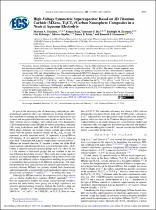 ResearchSpace
ResearchSpace
High-voltage symmetric supercapacitor based on 2D Titanium Carbide (MXene, Ti2CTx)/carbon nanosphere composites in a neutral aqueous electrolyte
JavaScript is disabled for your browser. Some features of this site may not work without it.
- ResearchSpace
- →
- Research Publications/Outputs
- →
- Journal Articles
- →
- View Item
| dc.contributor.author |
Melchior, SA

|
|
| dc.contributor.author |
Raju, Kumar

|
|
| dc.contributor.author |
Ike, IS

|
|
| dc.contributor.author |
Erasmus, RM

|
|
| dc.contributor.author |
Kabongo, G

|
|
| dc.contributor.author |
Sigalas, L

|
|
| dc.contributor.author |
Iyuke, SE

|
|
| dc.contributor.author |
Ozoemena, KI

|
|
| dc.date.accessioned | 2019-03-27T09:27:33Z | |
| dc.date.available | 2019-03-27T09:27:33Z | |
| dc.date.issued | 2018-02 | |
| dc.identifier.citation | Melchior, S.A. et al. 2018. High-voltage symmetric supercapacitor based on 2D Titanium Carbide (MXene, Ti2CTx)/carbon nanosphere composites in a neutral aqueous electrolyte. Journal of The Electrochemical Society, vol. 165(3): 501-511 | en_US |
| dc.identifier.issn | 1945-7111 | |
| dc.identifier.issn | 0013-4651 | |
| dc.identifier.uri | http://jes.ecsdl.org/content/165/3/A501.full | |
| dc.identifier.uri | Doi: 10.1149/2.0401803jes | |
| dc.identifier.uri | http://hdl.handle.net/10204/10867 | |
| dc.description | Open access article published in Journal of The Electrochemical Society, vol. 165(3): 501-511 | en_US |
| dc.description.abstract | The energy storage performance of one of the lightest-known MXenes, Ti2CTx (MX) combined with carbon nanospheres (CNS) has been investigated as a symmetric electrode system in an aqueous electrolyte (1 M Li2SO4). The energy storage properties were interrogated using cyclic voltammetry (CV), galvanostatic cycling with potential limitation (GCPL), electrochemical impedance spectroscopy (EIS) and voltage-holding tests. The combined material (MX/CNS) demonstrated a higher specific capacity compared to each of the individual components. The material was fabricated with relatively high and low mass loadings, assembled into a symmetric device and performance compared. Specific capacitance, specific power and specific energy for the lower electrode mass loading of 180 F·g-1, 37.6 kW·kg-1 and 14.1 W·h·kg-1 were all higher than 86 F·g-1, 20.1 kW·kg-1 and 6.7 W·h·kg-1 for the higher mass loading. A wide voltage window of 1.5 V was obtained, but with limited long-term cycling behavior, suggesting the need for future improvement. Mathematical modelling and simulation of the supercapacitor showed good correlation with the experimental results, validating the model. The results reveal the potential of the Ti2CTx to be employed as a viable energy storage system for lightweight applications. | en_US |
| dc.language.iso | en | en_US |
| dc.publisher | Electrochemical Society | en_US |
| dc.relation.ispartofseries | Worklist;22282 | |
| dc.subject | Mxene | en_US |
| dc.subject | Supercapacitors | en_US |
| dc.subject | Symmetric Supercapacitors | en_US |
| dc.title | High-voltage symmetric supercapacitor based on 2D Titanium Carbide (MXene, Ti2CTx)/carbon nanosphere composites in a neutral aqueous electrolyte | en_US |
| dc.type | Article | en_US |
| dc.identifier.apacitation | Melchior, S., Raju, K., Ike, I., Erasmus, R., Kabongo, G., Sigalas, L., ... Ozoemena, K. (2018). High-voltage symmetric supercapacitor based on 2D Titanium Carbide (MXene, Ti2CTx)/carbon nanosphere composites in a neutral aqueous electrolyte. http://hdl.handle.net/10204/10867 | en_ZA |
| dc.identifier.chicagocitation | Melchior, SA, Kumar Raju, IS Ike, RM Erasmus, G Kabongo, L Sigalas, SE Iyuke, and KI Ozoemena "High-voltage symmetric supercapacitor based on 2D Titanium Carbide (MXene, Ti2CTx)/carbon nanosphere composites in a neutral aqueous electrolyte." (2018) http://hdl.handle.net/10204/10867 | en_ZA |
| dc.identifier.vancouvercitation | Melchior S, Raju K, Ike I, Erasmus R, Kabongo G, Sigalas L, et al. High-voltage symmetric supercapacitor based on 2D Titanium Carbide (MXene, Ti2CTx)/carbon nanosphere composites in a neutral aqueous electrolyte. 2018; http://hdl.handle.net/10204/10867. | en_ZA |
| dc.identifier.ris | TY - Article AU - Melchior, SA AU - Raju, Kumar AU - Ike, IS AU - Erasmus, RM AU - Kabongo, G AU - Sigalas, L AU - Iyuke, SE AU - Ozoemena, KI AB - The energy storage performance of one of the lightest-known MXenes, Ti2CTx (MX) combined with carbon nanospheres (CNS) has been investigated as a symmetric electrode system in an aqueous electrolyte (1 M Li2SO4). The energy storage properties were interrogated using cyclic voltammetry (CV), galvanostatic cycling with potential limitation (GCPL), electrochemical impedance spectroscopy (EIS) and voltage-holding tests. The combined material (MX/CNS) demonstrated a higher specific capacity compared to each of the individual components. The material was fabricated with relatively high and low mass loadings, assembled into a symmetric device and performance compared. Specific capacitance, specific power and specific energy for the lower electrode mass loading of 180 F·g-1, 37.6 kW·kg-1 and 14.1 W·h·kg-1 were all higher than 86 F·g-1, 20.1 kW·kg-1 and 6.7 W·h·kg-1 for the higher mass loading. A wide voltage window of 1.5 V was obtained, but with limited long-term cycling behavior, suggesting the need for future improvement. Mathematical modelling and simulation of the supercapacitor showed good correlation with the experimental results, validating the model. The results reveal the potential of the Ti2CTx to be employed as a viable energy storage system for lightweight applications. DA - 2018-02 DB - ResearchSpace DP - CSIR KW - Mxene KW - Supercapacitors KW - Symmetric Supercapacitors LK - https://researchspace.csir.co.za PY - 2018 SM - 1945-7111 SM - 0013-4651 T1 - High-voltage symmetric supercapacitor based on 2D Titanium Carbide (MXene, Ti2CTx)/carbon nanosphere composites in a neutral aqueous electrolyte TI - High-voltage symmetric supercapacitor based on 2D Titanium Carbide (MXene, Ti2CTx)/carbon nanosphere composites in a neutral aqueous electrolyte UR - http://hdl.handle.net/10204/10867 ER - | en_ZA |





